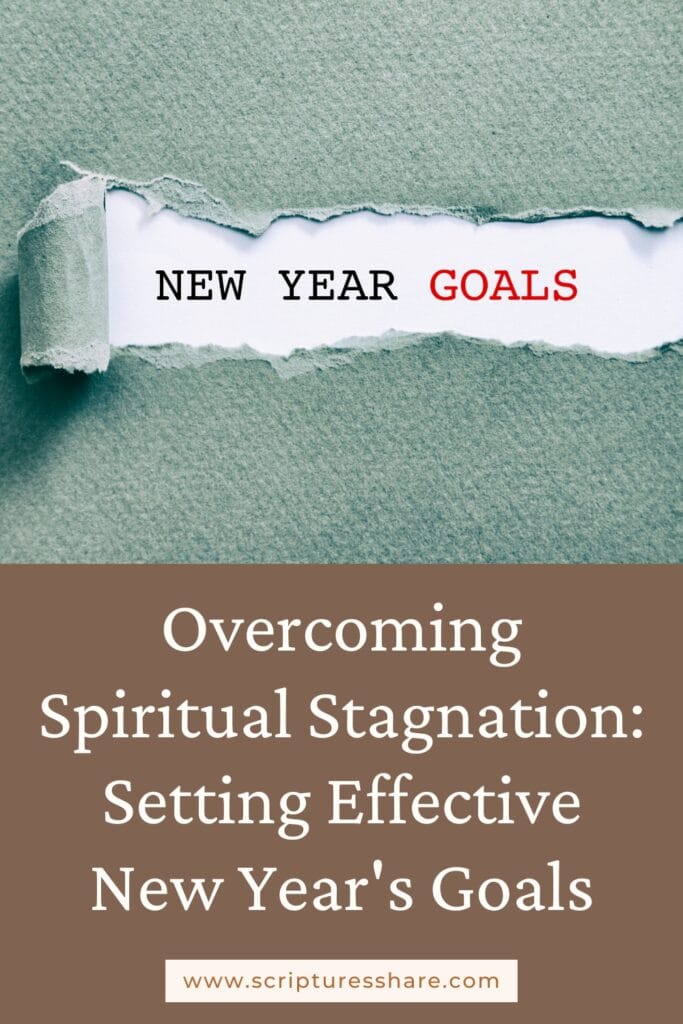No products in the cart.
Overcoming Spiritual Stagnation: Setting Effective New Year’s Goals
This post contains paid and/or affiliate links. I make a small commission at no extra cost to you. Please see our Privacy Policy.
As the new year starts, many people think about their spiritual paths. Feeling stuck or uninspired is common. Making New Year’s resolutions can help spark your spiritual growth.
Understanding Spiritual Stagnation
Spiritual stagnation is feeling disconnected from your beliefs. It can make you feel stuck or unfulfilled. The first step is to recognize this feeling and want to grow.
Identifying Your Spiritual Goals
Before making resolutions, think about what you want to improve in your spiritual life. Ask yourself:
- What parts of my beliefs do I want to explore deeper?
- Are there spiritual practices I’ve ignored that could help me?
- How can I connect with others who share my spiritual views?
Knowing your goals helps you make clear, achievable resolutions.
“You are never too old to set another goal or to dream a new dream.” – C.S. Lewis
(A reminder that it’s never too late to rekindle your spiritual journey.)
Setting SMART Resolutions
The SMART framework is great for setting goals:
- Specific: Clearly state what you aim to achieve.
- Measurable: Find ways to track your progress.
- Attainable: Set goals that are challenging but possible.
- Relevant: Ensure your goals match your spiritual values.
- Time-bound: Set deadlines to stay focused.
For example, instead of saying “I want to be more spiritual,” say “I will meditate for 10 minutes every morning for a month.” Specific goals lead to clearer paths to growth.
ADVERTISEMENT

Daily Practices
Every day, do things that help your spiritual growth. Try these:
- Meditation: Take a few quiet moments each day.
- Gratitude Journaling: Write down three things you’re thankful for each evening.
- Reading Spiritual Texts: Spend time each week reading inspiring books.
- Nature Walks: Connect with nature to feel closer to the universe.
Doing these daily can help you grow spiritually.
Finding Community Support
Connecting with others can boost your spiritual journey. Look for groups that share your beliefs. Sharing experiences and learning from others can be very helpful. Look for:
- Local spiritual centers or congregations
- Online forums and social media groups
- Workshops or retreats on spiritual growth
Being part of a supportive community can make you more excited and give you new insights.
Reflecting on Your Progress
As the year goes on, check in on your resolutions. Ask yourself:
- Have I stayed true to my goals?
- What practices have helped me grow spiritually?
- What can I do to stay motivated?
Reflecting helps you stay on track and make changes if needed. It can also refresh your spirit and add energy to your journey.
“Faith is taking the first step even when you don’t see the whole staircase.” – Martin Luther King Jr.
(Encouraging you to take small but purposeful steps toward spiritual renewal.)
Overcoming spiritual stagnation is a journey that needs effort, reflection, and action. By setting effective New Year’s resolutions, you can start your spiritual growth.
Use this chance to reconnect with yourself and deepen your spiritual life in the new year.
The Importance of Self-Reflection in Setting Spiritual Goals
Setting spiritual goals can greatly improve your life. It’s not just about rituals or practices. It’s about understanding yourself deeply. Self-reflection is key to finding what you really want in your spiritual journey.
Self-reflection means thinking about your thoughts, feelings, and actions. It helps you understand your motivations and values. Regular self-reflection helps you find where you might feel stuck spiritually.
Here are some benefits of self-reflection:
- Awareness: You understand your spiritual needs and desires.
- Clarity: You know your beliefs and values better.
- Focus: You can set focused, realistic goals.
- Growth: It encourages personal growth and change.
- Alignment: Your goals match who you truly are.
Self-reflection helps you question your spiritual practices. Ask if you’re happy with your spiritual life. Are your routines helping you grow? By asking these questions, you can see what needs improvement.
Journaling is a great way to document your thoughts. Here’s how to start:
ADVERTISEMENT
- Set aside time each day to write.
- Reflect on your spiritual experiences and feelings.
- Look for recurring themes or emotions that need attention.
- Use your reflections to find spiritual goals.
Understanding yourself makes setting spiritual goals easier. Aim for goals that are specific, measurable, achievable, relevant, and time-bound (SMART). Here’s an example:
| Goal Aspect | Example |
|---|---|
| Specific | Read one spiritual book each month. |
| Measurable | Track the number of pages read weekly. |
| Achievable | Choose books that interest you and fit your schedule. |
| Relevant | Select books that align with your beliefs and questions. |
| Time-bound | Complete each book by the end of the month. |
Setting goals is just the beginning. Regularly check in with yourself to see how you’re doing. Ask yourself questions like:
- What worked well?
- What challenges did I face?
- How do I feel about my progress?
By asking these questions, you can adjust your goals if needed. Remember, your spiritual journey is personal and changes over time. Be flexible and allow yourself to grow.
Sharing your spiritual journey with others can deepen connections and offer new insights. Join a community or group that shares your interests. Discussing your reflections and goals can provide support and motivation.
Self-reflection is like holding a mirror to your soul. It helps you understand yourself and your spiritual journey. By using self-reflection in goal-setting, you can overcome stagnation and grow.
This practice helps you set meaningful spiritual goals that resonate with you.
How Vision Board for Spiritual Growth Can Help
Creating a vision board is a powerful way to manifest your spiritual growth. It acts as a visual representation of your aspirations, guiding you toward your spiritual goals.
This technique not only ignites inspiration but also offers a tangible reminder to keep you focused on your journey.
To start, gather all the materials you will need. Here’s a simple list to kick off your vision board:
- Poster board or corkboard
- Magazines or printouts
- Scissors
- Glue or tape
- Markers or pens
- Decorative items (stickers, washi tape, etc.)
Once you have everything ready, it’s essential to reflect on what “spiritual growth” means to you. This reflection can guide the elements you choose for your vision board. Think about the following:
- Values you want to develop (love, compassion, gratitude)
- Practices you wish to incorporate (meditation, yoga, journaling)
- Inspirational figures or quotes that resonate with your journey
- Symbols representing your spiritual aspirations
After this reflection, take a moment to scan through magazines or online resources. Cut out images and words that resonate with your thoughts and emotions. Keep an open mind. You might find something unexpected that speaks to your soul.
As you begin to assemble your vision board, consider the layout. There are a few methods to arrange your board for clarity and impact:
- Thematic Sections: Divide the board into areas for different aspects of your spiritual growth, such as personal development, practices, and inspirational messages.
- Inspirational Quotes: Place quotes from spiritual leaders or mentors that motivate you amidst images.
- Color Schemes: Use colors that resonate with specific energies or vibrations that you want to amplify in your life.
Once everything is in place, it’s time to glue everything down. As you do, visualize these goals coming to life. Imagine yourself embodying each aspiration. Remember, this board is not just a collage; it’s a tool to help you remain focused and positive.
After you’ve completed your vision board, set a place for it where you will see it daily. It could be above your desk, in your meditation corner, or even as your phone wallpaper.
Regular exposure to your goals reinforces your commitment and keeps your intentions top of mind.
To make the most of your vision board, incorporate a few strategies:
- Daily Affirmations: Speak positively about your aspirations as you look at your vision board. This reinforces your goals.
- Monthly Check-ins: Assess your progress regularly. Are there areas where you’ve grown? What’s next?
- Modify As You Grow: Don’t hesitate to add new elements or remove ones that no longer resonate with you.
These practices will further enhance the effectiveness of your vision board as a spiritual growth tool. Remember, it’s not just about creating a beautiful board; it’s about fostering a deeper connection with yourself and your aspirations.
This process encourages you to be mindful and intentional about your spiritual journey. By putting pen to paper and images to board, you effectively ignite a journey filled with possibilities.
| Material | Purpose |
|---|---|
| Poster Board | Base for your vision board |
| Magazines/Printouts | Images and words that inspire you |
| Scissors | To cut out elements |
| Glue/Tape | To attach items to the board |
| Markers | For writing affirmations or notes |
Creating a vision board for your spiritual growth is a profound exercise. It not only helps you clarify your goals but also enhances your life’s journey.
By integrating your values, practices, and inspirations visually, you’re setting the foundation for a year filled with growth, love, and enlightenment.
“Spiritual growth requires intentional effort, not accidental moments.” – Unknown
(A call to set clear, faith-driven goals to overcome stagnation.)
Building a Support Network for Your Spiritual Journey
Starting a spiritual journey is a personal and life-changing experience. It comes with challenges, but having a strong support network helps.
Being around people who share your beliefs can offer encouragement and insights. Here are key steps to build a meaningful support network for your spiritual path.
Identify Your Needs
Before you start looking for support, think about what you need. Ask yourself:
- What parts of my spiritual journey are hard for me?
- Do I need emotional support, knowledge, or practical advice?
- Am I looking for a community, mentors, or both?
Knowing what you need will guide your search for the right people.
Explore Local Communities
Connecting with local spiritual groups is a great way to meet like-minded people. Look for:
- Spiritual centers: Many cities have meditation or yoga studios, churches, and well-being shops with regular meetings or workshops.
- Meetup groups: Websites like Meetup.com have groups focused on spiritual exploration, mindful practices, and personal growth.
- Workshops and retreats: Attending these can deepen your spiritual practice and help you meet others with similar interests.
Utilize Online Platforms
If local options are scarce, online platforms can connect you with others. Consider using:
- Social media groups: Search for Facebook groups or Instagram communities focused on spirituality. Engage in discussions, ask questions, and share your thoughts.
- Online forums: Websites like Reddit or specialized spiritual forums offer valuable insights and connections worldwide.
- Virtual events: Many spiritual leaders host webinars or online classes. Participating in these can help you meet others who resonate with your journey.
Engage in One-on-One Connections
While group settings are helpful, forming deep relationships with individuals can offer immense support. Here’s how to create those personal connections:
- Reach out after events: If you meet someone at a workshop or community event, don’t hesitate to exchange contact information and follow up.
- Schedule regular check-ins: Create a routine with friends or mentors for ongoing discussions about your spiritual growth.
- Offer to support: Support is a two-way street. Being available for others can strengthen your own journey and foster trust.
Participate in Group Activities
Getting involved in group activities can enhance your spiritual experience. Join classes, group meditations, or communal rituals.
Participating actively in these settings can help you form connections while deepening your practice. Here are some activities to consider:
- Meditation groups: Regular meditation can help you stay grounded and offer a chance to connect.
- Book clubs: Join a spiritual book club to explore new ideas and share perspectives.
- Service projects: Engage in community service with others to create bonds while giving back.
Practice Open Communication
No relationship thrives without clear communication. Discuss your spiritual goals and struggles with your network. Let them know how they can best support you. Remember to:
- Be honest about your feelings
- Ask for help when you need it
- Offer your insights to others
Effective communication can strengthen your connections and create a more fulfilling support network.
Regularly Evaluate Your Network
As you progress on your spiritual journey, your needs may change. Regularly assess your support network:
- Are the connections nurturing and uplifting?
- Do they contribute positively to your journey?
- Should you seek new connections or reinforce existing ones?
This evaluation ensures that your network evolves alongside your spiritual growth.
By establishing a robust support network, you can enhance your spiritual journey with encouragement, understanding, and shared experiences. Remember, building this network is a journey in itself. Embrace the process and enjoy the connections you create along the way.
Mindfulness Practices to Enhance Your New Year Resolutions
The New Year is a time for fresh starts. Many of us reflect on our lives and set goals. But, how many of these goals stick? Mindfulness can help by making you more aware and focused.
When you add mindfulness to your goal-setting, it’s easier to stay on track. This is because mindfulness connects you deeply with your goals. It makes them feel more real and achievable.
Here are several mindfulness practices to enhance your New Year resolutions:
Practice Gratitude
Starting with gratitude is powerful. Acknowledging what you’re thankful for shifts your focus. It helps you stay motivated to reach your goals.
- Keep a gratitude journal and write three things you are thankful for each day.
- Share your gratitude with others at least once a week.
- Reflect on how gratefulness can impact your resolutions.
Set Intentions, Not Just Goals
Goals are important, but intentions drive your actions. Intentions remind you of your purpose. Before the year starts, reflect on what you truly want to achieve.
- Use the following prompts to set your intentions:
- What core values do I want to honor this year?
- How do I want to feel throughout the year?
- What small changes can I make that align with my larger goals?
Cultivate Mindfulness Through Meditation
Meditation helps center your mind and reduce distractions. It keeps you focused on the present moment. This is key when trying to keep resolutions. Here’s how to get started:
- Find a quiet space where you won’t be disturbed.
- Set a timer for 5-10 minutes to start.
- Focus on your breath and gently redirect your mind whenever it wanders.
- Consider using meditation apps for guided sessions.
Regular meditation practice boosts your emotional resilience. It helps you handle life’s ups and downs better.
Visualize Your Success
Visualization is a technique that involves imagining yourself achieving your goals. It helps your brain create a roadmap for success. Here’s how to incorporate visualization into your resolution journey:
- Find a comfortable position and close your eyes.
- Picture yourself achieving your goals in as much detail as possible.
- Feel the emotions associated with your success—joy, pride, fulfillment.
- Repeat this practice regularly to reinforce your commitment.
Embrace Mindful Living
Mindful living means being present in every aspect of life. It makes it easier to stay aligned with your resolutions. Here are some tips to help you embrace this lifestyle:
- Focus on one task at a time to avoid overwhelm.
- Incorporate awareness in routine activities, like eating or walking.
- Limit distractions by putting away your phone or turning off notifications.
| Practice | Benefits |
|---|---|
| Gratitude Journal | Enhances positive thinking |
| Meditation | Improves focus and emotional resilience |
| Visualization | Creates a mental roadmap for success |
| Mindful Living | Promotes present-moment awareness and reduces stress |
By adding these mindfulness practices to your New Year resolutions, you create a supportive environment for growth. These practices encourage self-awareness. This is key for recognizing when you need to adjust your path.
Remember, the key to successful resolutions is to nurture your intentions mindfully.
As you start this journey, be gentle with yourself. Every step counts, and progress takes time. Understanding this can lead to significant change.
Conclusion
Thinking about your spiritual journey can spark real change. To move past spiritual blocks, you need to take action. Setting New Year’s goals can change your spiritual life if you’re serious and dedicated.
Self-reflection is key. Understanding your beliefs, values, and dreams helps you find what truly matters to you. This clarity lets you set spiritual goals that match who you are and who you want to be.
Creating a vision board is a great way to visualize your spiritual growth. It makes your dreams real and keeps them in front of you every day. It motivates you to keep moving forward.
Having a support network is also important. Being around people who share your beliefs helps you stay motivated and accountable. Sharing your journey with others can make it stronger and more meaningful.
Adding mindfulness to your goals can deepen your spiritual connection. Practices like meditation or journaling help you stay grounded. They make it easier to deal with spiritual blocks.
By using these strategies, you’re ready for a fulfilling spiritual year. This New Year, embrace the chance to grow and become more awake. You have the power to change your spirituality—start now!













